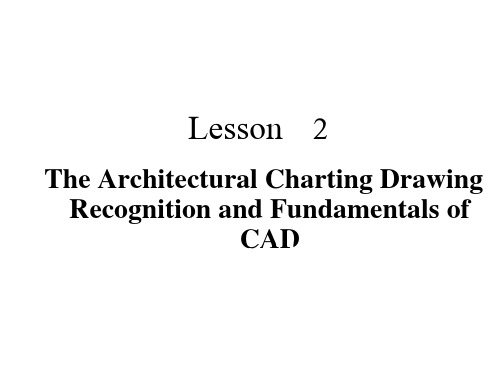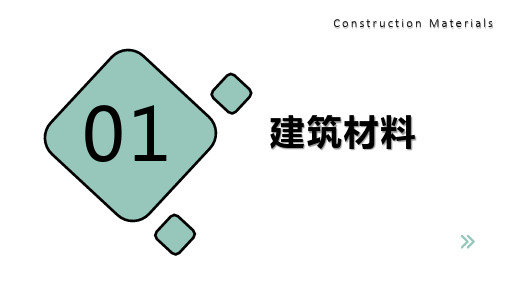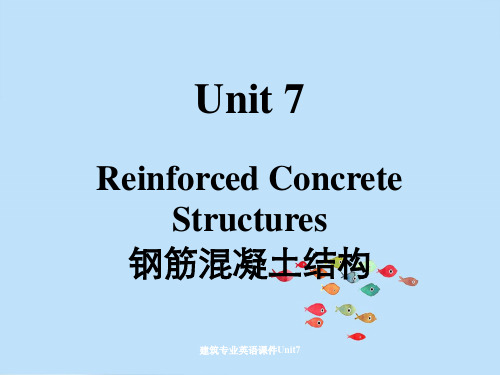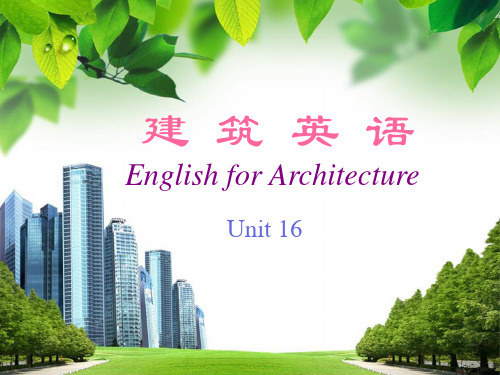建筑工程英语专业英语unitPPT课件
合集下载
建筑工程专业英语unit

Fig 2.1 Projection process
Projections commonly used in the project are three-plane projection drawing, the axonometric drawing and the perspective drawing .
projection phenomenon three-dimensional
投影现象 三维
Three basic elements that the projection must have are the projection line, the object, the projecting plane.
horizontal projection drawing frontal projection drawing profile projection drawing
水平投影图 正面投影图 侧面投影图
Fig4.3 is a building, Fig4.4 is it’s horizontal plane, Fig4.5 is south elevation and Fig4.6 is the section. Take the horizontal plane for an example to explain the reading method.
However designers tend to communicate most project information in graphical forms. Drawings have always been central to the whole construction process, and are likely to continue as such in the foreseeable future.
Projections commonly used in the project are three-plane projection drawing, the axonometric drawing and the perspective drawing .
projection phenomenon three-dimensional
投影现象 三维
Three basic elements that the projection must have are the projection line, the object, the projecting plane.
horizontal projection drawing frontal projection drawing profile projection drawing
水平投影图 正面投影图 侧面投影图
Fig4.3 is a building, Fig4.4 is it’s horizontal plane, Fig4.5 is south elevation and Fig4.6 is the section. Take the horizontal plane for an example to explain the reading method.
However designers tend to communicate most project information in graphical forms. Drawings have always been central to the whole construction process, and are likely to continue as such in the foreseeable future.
建筑专业英语课件unit 10 B

UNIT 10
• Text B Proportioning and Mixing of Concrete • Words and Expressions • Gradation n. 分类,分级,级配 • Fluidity n. 流动性 • Customary a. 习惯的 • cement paste 水泥浆
• Sack n. 袋,包,一袋,一包;vt. 灌袋 • water-cement ratio 水灰比 • Batch n. 配料,定量混合物,一批;v. 分批配料,分类,分组 • trial-batch (混凝土的)小量试拌 • Truncate v. 截去……的顶端(末端), 缩短,截去 • Cone n. 锥体,锥形;v. 使成锥形,形成 锥面 • Inevationary a. 固定的,定点的 Haul n. 搬运,运程v. 搬运,运输 Discharge v. 卸货,卸载,放出 Agitator n. 搅拌器,搅拌机,混 合器 • batching plant (混凝土)拌和厂 • • • •
1、FOOL'S GARDEN---Lemon GARDEN---Lemon 2、dido---whiteflag dido---whiteflag
• Scatter v. 分散 • Furnish v. 提供,供应 • Admixture n. 混合物,掺和物,外 加剂 • Plasticizer n. 增塑剂,塑化剂,增韧剂 • Hopper n. 漏斗,装料斗,底卸式车 • Fraction n. 小部分 • revolving-drum mixer 转 筒式搅拌机 • ready-mixed 预拌的,搅拌好的 • transit-mixed 运送时搅拌的
• Text B Proportioning and Mixing of Concrete • Words and Expressions • Gradation n. 分类,分级,级配 • Fluidity n. 流动性 • Customary a. 习惯的 • cement paste 水泥浆
• Sack n. 袋,包,一袋,一包;vt. 灌袋 • water-cement ratio 水灰比 • Batch n. 配料,定量混合物,一批;v. 分批配料,分类,分组 • trial-batch (混凝土的)小量试拌 • Truncate v. 截去……的顶端(末端), 缩短,截去 • Cone n. 锥体,锥形;v. 使成锥形,形成 锥面 • Inevationary a. 固定的,定点的 Haul n. 搬运,运程v. 搬运,运输 Discharge v. 卸货,卸载,放出 Agitator n. 搅拌器,搅拌机,混 合器 • batching plant (混凝土)拌和厂 • • • •
1、FOOL'S GARDEN---Lemon GARDEN---Lemon 2、dido---whiteflag dido---whiteflag
• Scatter v. 分散 • Furnish v. 提供,供应 • Admixture n. 混合物,掺和物,外 加剂 • Plasticizer n. 增塑剂,塑化剂,增韧剂 • Hopper n. 漏斗,装料斗,底卸式车 • Fraction n. 小部分 • revolving-drum mixer 转 筒式搅拌机 • ready-mixed 预拌的,搅拌好的 • transit-mixed 运送时搅拌的
《建筑英语》课件unit 2Construction Engineering

English for Architecture
Unit 2 Construction Engineering
Read to Know
Construction Engineering 建筑施工
All civil engineering projects have four distinct phases: planning, designing, construction and operation. The construction phase turns the project design into reality and the civil engineering contractor is responsible for the construction work. His overall objective is to complete the construction work efficiently within an estimated time to maximize his profits on the contract.
现场准备 包括移走和清理拟建场地地表上所有的建筑和生长物。对于小型建筑和树木采用推土机即
可,大型建筑必须拆除。
Unit 2 Construction Engineering
Earthmoving This includes excavation and the placement of earth fill. Excavation follows preparation of the site, and is performed when the existing grade must be brought down to a new elevation. Excavation generally starts with the separate stripping of the organic topsoil, which is later reused for landscaping around the new structure. Excavation may be done by any several excavaters, such as shovels, draglines, clamshells, cranes, scrapers .
第二章 建设材料和建筑结构 工程管理专业英语ppt课件

虽然现浇混凝土具备更大的灵活性和适应性,但一般很难控
制其混合料,特别是在天气条件不好的情况下。
Review Questions and Problems
1.What are the types of foundations? List some examples for each type of foundation.
Reading material
The Total Cost of Building Materials
2 . Ecological Costs •Pollution costs can be macro and micro. The macro, environmental pollution of extraction industries building materials rely on such as mining, petroleum, and logging produce environmental damage at their source and in transportation of the raw materials, manufacturing, transportation of the products, retailing, and installation. An example of the micro aspect of pollution is the off-gassing of the building materials in the building or indoor air pollution. Red List building materials are materials found to be harmful. Also the carbon footprint, the total set of greenhouse gas emissions produced in the ysis also includes the reuse, recycling, or disposal of construction waste. Two concepts in building which account for the ecological economics of building materials are green building and sustainable development.
制其混合料,特别是在天气条件不好的情况下。
Review Questions and Problems
1.What are the types of foundations? List some examples for each type of foundation.
Reading material
The Total Cost of Building Materials
2 . Ecological Costs •Pollution costs can be macro and micro. The macro, environmental pollution of extraction industries building materials rely on such as mining, petroleum, and logging produce environmental damage at their source and in transportation of the raw materials, manufacturing, transportation of the products, retailing, and installation. An example of the micro aspect of pollution is the off-gassing of the building materials in the building or indoor air pollution. Red List building materials are materials found to be harmful. Also the carbon footprint, the total set of greenhouse gas emissions produced in the ysis also includes the reuse, recycling, or disposal of construction waste. Two concepts in building which account for the ecological economics of building materials are green building and sustainable development.
建筑学专业英语课件

1.Vocabulary
7) structure n.结构,构造;建筑物,构筑物
~ in space: 空间结构(桁架,网架等) ~ plan: 结构设计,结构方案 ~ types: 结构类型
structural a.结构的,构造的;建筑上的
~ behavior: 构造性能,结构特征 ~ carpentry: 大木作,木结构 ~ drawings: 结构图 ~ wall: 承重墙
Unit 1: Architecture
1.Vocabulary
21) doorway n. 门口,门前通道 door window n. 落地窗 door class n. 门(防火)等级
22) site n. 地点,位置,基址;工地,现场
~ analysis : 场地分析 ~ plan : 场地平面图,总布置图 ~ planning : 场地规划,总平面设计 ~ selection : 选址 ~ of construction : 施工现场,建筑工地
14) property n. 财富,资产,所有权,地产; 性质,性能
~ line : 地界线,建筑红线
Unit 1: Architecture
1.Vocabulary
15) grid n. 格子,隔栅
gridiron n. 格状结构;铁篦子
16) cantilever n. 悬臂,悬臂梁
~ bridge : 悬臂桥
Unit 1: Architecture
1.Vocabulary
architectural a. 建筑的;建筑学的
~ acoustics: 建筑声学 ~ appearence: 建筑外观 ~ area: 建筑面积 ~ complex: 建筑群,建筑总体 ~ design :建筑设计 ~ lighting :建筑采光,建筑照明 ~ specifications :建筑规范 ~ style :建筑风格,建筑式样 ~ working drawing :建筑施工图
7) structure n.结构,构造;建筑物,构筑物
~ in space: 空间结构(桁架,网架等) ~ plan: 结构设计,结构方案 ~ types: 结构类型
structural a.结构的,构造的;建筑上的
~ behavior: 构造性能,结构特征 ~ carpentry: 大木作,木结构 ~ drawings: 结构图 ~ wall: 承重墙
Unit 1: Architecture
1.Vocabulary
21) doorway n. 门口,门前通道 door window n. 落地窗 door class n. 门(防火)等级
22) site n. 地点,位置,基址;工地,现场
~ analysis : 场地分析 ~ plan : 场地平面图,总布置图 ~ planning : 场地规划,总平面设计 ~ selection : 选址 ~ of construction : 施工现场,建筑工地
14) property n. 财富,资产,所有权,地产; 性质,性能
~ line : 地界线,建筑红线
Unit 1: Architecture
1.Vocabulary
15) grid n. 格子,隔栅
gridiron n. 格状结构;铁篦子
16) cantilever n. 悬臂,悬臂梁
~ bridge : 悬臂桥
Unit 1: Architecture
1.Vocabulary
architectural a. 建筑的;建筑学的
~ acoustics: 建筑声学 ~ appearence: 建筑外观 ~ area: 建筑面积 ~ complex: 建筑群,建筑总体 ~ design :建筑设计 ~ lighting :建筑采光,建筑照明 ~ specifications :建筑规范 ~ style :建筑风格,建筑式样 ~ working drawing :建筑施工图
建筑工程专业英语课件专业英语第3单元

Text A Components of a Building
Construction of Foundation Foundation is a very important part of a building. Foundation
engineering is a special subject. A foundation engineer should know how to examine the soil profile and arrive at a suitable foundation. The following are some of the different types of foundation generally used:
1. Planning the orientation, layout and dimension of the rooms of the building
2. The preparation of the features to make the building attractive Work of this nature for small buildings may be taken by nonarchitects also. However, the construction of a building should always be carried out under the supervision of a qualified person. We will now briefly examine the construction of the different components of buildings.
Text A Components of a Building
建筑工程专业英语课件(全)

是If…条件句。 【例6】The huge investment in the infrastructure will be
erased quickly if proper maintenance and rehabilitation procedures are enforced and funded. 如果合理的养护和修复计划得以资助并实施,就可迅速取消用 于基础建设的巨大投资。
Unit1
一、本单元学习要求 二、text学习 介绍text专业背景 词汇和短语 课程内容分析 课程内容难点分析 完成课后练习 三、reading material作为课后要求 四、supplement学习
一、本单元学习要求
1、掌握关于土木工程常用的英语专业词汇 的表示;
2、通过课程内容分析,概括土木工程所包 含的内容,并与中文专业表述进行比较, 进一步理解专业英语的表述;
combustible 可燃的
a.易燃的,
plotting municipal
n.测绘,标图 a.市政的,
市立的,地方自治的
ramp n.斜坡,斜 commission n.委任,
面,滑行台
委任(事项),委员会
excavate 开凿
precisely 正好地
v.挖掘,
runoff n.雨量,流量, 超高缓和段
subcontractor n.转包合
同,转包商,次承包商
asphalt n.地沥青
aluminum n.铝
lock
n.水闸,闸门
fill
n.填土,填方
scrubber n.洗涤器,涤
气器,滤清器
incineration n.烧尽,焚
化
toxic
erased quickly if proper maintenance and rehabilitation procedures are enforced and funded. 如果合理的养护和修复计划得以资助并实施,就可迅速取消用 于基础建设的巨大投资。
Unit1
一、本单元学习要求 二、text学习 介绍text专业背景 词汇和短语 课程内容分析 课程内容难点分析 完成课后练习 三、reading material作为课后要求 四、supplement学习
一、本单元学习要求
1、掌握关于土木工程常用的英语专业词汇 的表示;
2、通过课程内容分析,概括土木工程所包 含的内容,并与中文专业表述进行比较, 进一步理解专业英语的表述;
combustible 可燃的
a.易燃的,
plotting municipal
n.测绘,标图 a.市政的,
市立的,地方自治的
ramp n.斜坡,斜 commission n.委任,
面,滑行台
委任(事项),委员会
excavate 开凿
precisely 正好地
v.挖掘,
runoff n.雨量,流量, 超高缓和段
subcontractor n.转包合
同,转包商,次承包商
asphalt n.地沥青
aluminum n.铝
lock
n.水闸,闸门
fill
n.填土,填方
scrubber n.洗涤器,涤
气器,滤清器
incineration n.烧尽,焚
化
toxic
建筑专业英语课件Unit7

费用。当然,这是一个建造结构而必需的材 料和劳动力费用的函数。但是,总费用经常 同样地或更多地受总的建造时间的影响,因 为承包商和业主必须分配资金来进行建造, 并直到建筑物可以使用才能收回投资。因快 速施工而使财务的节约可足以抵消增加的材 料费用。设计者为使设计和加工标准化所采 取的任何措施通常都将在降低的总费用中得 益。
影响一个结构选择混凝土的因素
The choice of whether a structure should be built of concrete, steel, masonry, or timber(木 材)depends on the availability(可得性)of materials and on a number of(许多)value decisions(价值判断).
混凝土受压强、受拉弱。因此,每当受 荷、收缩受阻或温度变化引起的拉应力超过 混凝土的抗拉强度时,便会发生开裂。在素 混凝土梁中,因外力引起的力矩由内部的拉 -压形成的力偶来抵抗,此力偶中包含了混 凝土的拉力。当第一条裂缝形成时,此梁会 突然、完全地失效。在钢筋混凝土梁中,钢 筋埋置在混凝土内的方式应能使混凝土开裂 后在钢筋中产生平衡力矩所需的拉力。
costs. Any measures designer can take to standardize the design and forming(加工)will generally pay off(使人 得益)in reduced overall costs.
建筑专业英语课件Unit7
经济性 最重要的考虑常常是该结构的总
建筑专业英语课件Unit7
The construction(施工)of a reinforced concrete member involves building a form or mold(模具)in the shape of the member being built. The form must be strong enough to support the weight and hydrostatic pressure(静水压力)of the wet concrete, and any forces applied to it by workers, concrete buggies(料 车), wind, and so on. The reinforcement(钢筋)is placed in this form and held in place(固定就位) during the concreting(用混凝土浇筑)operation. After the concrete has hardened, the forms are removed(拆除).
影响一个结构选择混凝土的因素
The choice of whether a structure should be built of concrete, steel, masonry, or timber(木 材)depends on the availability(可得性)of materials and on a number of(许多)value decisions(价值判断).
混凝土受压强、受拉弱。因此,每当受 荷、收缩受阻或温度变化引起的拉应力超过 混凝土的抗拉强度时,便会发生开裂。在素 混凝土梁中,因外力引起的力矩由内部的拉 -压形成的力偶来抵抗,此力偶中包含了混 凝土的拉力。当第一条裂缝形成时,此梁会 突然、完全地失效。在钢筋混凝土梁中,钢 筋埋置在混凝土内的方式应能使混凝土开裂 后在钢筋中产生平衡力矩所需的拉力。
costs. Any measures designer can take to standardize the design and forming(加工)will generally pay off(使人 得益)in reduced overall costs.
建筑专业英语课件Unit7
经济性 最重要的考虑常常是该结构的总
建筑专业英语课件Unit7
The construction(施工)of a reinforced concrete member involves building a form or mold(模具)in the shape of the member being built. The form must be strong enough to support the weight and hydrostatic pressure(静水压力)of the wet concrete, and any forces applied to it by workers, concrete buggies(料 车), wind, and so on. The reinforcement(钢筋)is placed in this form and held in place(固定就位) during the concreting(用混凝土浇筑)operation. After the concrete has hardened, the forms are removed(拆除).
建筑专业英语PPT

First, the ground is excavated. Then, the concrete foundations are constructed. Later, the column base plates are fixed. Finally, the steel columns are erected.
确定建筑物的一部分或这些句子中描述装配顺序的阶段:
a)This cannot be put in place until the upper floor steel columns have been erected. 这个不能到位,知道楼上树立好钢柱。
b)Before fixing these, the workmen erect the corner units. 在解决这些之前,工人们建造角落单位。
这个顺序划分为四个阶段或部分:
Phase 1
Ground is excavated
挖掘地基
Concrete foundations are constructed
混凝土基础构造
Column base plates are fixed 柱形基础板固定
Steel columns are erected 树立钢柱
Vertical cladding panels are fixed 固定垂直覆盖层板
Suspended ceilings are fixed 固定吊顶
Partitions are erected 划分区域
Services are installed in the ceiling void 在吊顶空间安装服务
首先,挖掘地基。然后,搭建混凝土基础构造。之后,确定柱形基础板。最后, 树立钢柱。
《建筑英语》课件 unit 16Intelligent Building

.
Unit 16
English for Architecture
Intelligent Building
智能建筑的系统构成 智能建筑环境内体现智能功能的主要组成部分有SIC、GC、BAS、CNS、OAS等五个部分,其中
建筑设备自动化系统(BAS)是由保安监控系统,火灾自动化报警与消防联动控制系统,照明监控系 统,供配电与备用应急电源监控系统,给水排水监控系统,交通监控系统等组成,达到安全、舒适、 节能、高效、环保的目的。在这里我们以保安监控系统;火灾自动化报警与消防联动控制系统为例,
to optimize system performance and simplify facility operations, it designs and offers a safe, comfortable, energy-consecrated, high-efficient, convenient working environment, according to analysis of the structure, system, service, management in building, etc. It integrates traditional architecture and modern 4C technology (Computer, Control, Communication and CRT Graphical display technology). It has already become the mainstream development of the construction in the 21st century.
智能建筑的概念 智能建筑将建筑管理与IT系统成功融合到优化系统性能和简易设备操作上,通过对建筑的结构、
Unit 16
English for Architecture
Intelligent Building
智能建筑的系统构成 智能建筑环境内体现智能功能的主要组成部分有SIC、GC、BAS、CNS、OAS等五个部分,其中
建筑设备自动化系统(BAS)是由保安监控系统,火灾自动化报警与消防联动控制系统,照明监控系 统,供配电与备用应急电源监控系统,给水排水监控系统,交通监控系统等组成,达到安全、舒适、 节能、高效、环保的目的。在这里我们以保安监控系统;火灾自动化报警与消防联动控制系统为例,
to optimize system performance and simplify facility operations, it designs and offers a safe, comfortable, energy-consecrated, high-efficient, convenient working environment, according to analysis of the structure, system, service, management in building, etc. It integrates traditional architecture and modern 4C technology (Computer, Control, Communication and CRT Graphical display technology). It has already become the mainstream development of the construction in the 21st century.
智能建筑的概念 智能建筑将建筑管理与IT系统成功融合到优化系统性能和简易设备操作上,通过对建筑的结构、
(推荐)《建筑系专业英语》PPT课件

1
2
3
4
What do we expect out of windows?
5
6
• I need a room overlooking sea.
7
8
9
10
11
12
13
14
15
16
17
18
19
Also we repeat, obviously this figure will vary
52
53
• The fact that openings in naturally occurring membranes are invariably thickened can be easily explained by considering how the lines of force in the membrane must flow around the hole. The increasing density of lines of force around the perimeter of the hole requires that additional material be generated there to prevent tearing.
Imagine: ABneitjainrcgt,icSah,aNnogrhthaei,rHnuNizohrwoua,y,gIutalnyg, zBhroauzi.li.a.n. jungle. . . .
38
What is the best approach to
OVERLOOKING LIFE ?
50
It is this thickening, around the eyes and mouth,
2
3
4
What do we expect out of windows?
5
6
• I need a room overlooking sea.
7
8
9
10
11
12
13
14
15
16
17
18
19
Also we repeat, obviously this figure will vary
52
53
• The fact that openings in naturally occurring membranes are invariably thickened can be easily explained by considering how the lines of force in the membrane must flow around the hole. The increasing density of lines of force around the perimeter of the hole requires that additional material be generated there to prevent tearing.
Imagine: ABneitjainrcgt,icSah,aNnogrhthaei,rHnuNizohrwoua,y,gIutalnyg, zBhroauzi.li.a.n. jungle. . . .
38
What is the best approach to
OVERLOOKING LIFE ?
50
It is this thickening, around the eyes and mouth,
第一章 建设工程实践 工程管理专业英语ppt课件

Please make a statement of the six phases in the construction project life cycle and their corresponding characteristics.
Construction Procurement Methods
上面的句型均可以表达某主语包括什么过程和活动,在英文书写中为了避免重复,可以采用 上述不同的表达方式。但是要区分介词to、in、for、of后面动词的表达形式。在上述语 法环境下,to后面需要加动词原形,in、for、of后面则加动名词。
Review Questions and Problems
Read through the PMBOK Guide (sixth edition) to understand the management processes for the ten project management knowledge areas mentioned above.
LOGO
•approve progress payments 批准进度付款 •issue [ˈɪʃuː] vt.发出;签署 •the magnitude of ……的意义;……的重要性 •prefer to 倾向于;更喜欢 •prior to 在……之前 •liability [ˌlaɪəˈbɪləti] n.债务;责任 •individual contractors 单个承包商
PMBOK将项目管理知识分为十个领域,是一种认为项 目工作是由(多个)过程完成的方法。
• Project integration management includes the processes and activities to... • Project scope management includes the processes required to... • Project cost managቤተ መጻሕፍቲ ባይዱment includes the processes involved in... • Project quality management includes the processes for... • Project risk management includes the processes of...
Construction Procurement Methods
上面的句型均可以表达某主语包括什么过程和活动,在英文书写中为了避免重复,可以采用 上述不同的表达方式。但是要区分介词to、in、for、of后面动词的表达形式。在上述语 法环境下,to后面需要加动词原形,in、for、of后面则加动名词。
Review Questions and Problems
Read through the PMBOK Guide (sixth edition) to understand the management processes for the ten project management knowledge areas mentioned above.
LOGO
•approve progress payments 批准进度付款 •issue [ˈɪʃuː] vt.发出;签署 •the magnitude of ……的意义;……的重要性 •prefer to 倾向于;更喜欢 •prior to 在……之前 •liability [ˌlaɪəˈbɪləti] n.债务;责任 •individual contractors 单个承包商
PMBOK将项目管理知识分为十个领域,是一种认为项 目工作是由(多个)过程完成的方法。
• Project integration management includes the processes and activities to... • Project scope management includes the processes required to... • Project cost managቤተ መጻሕፍቲ ባይዱment includes the processes involved in... • Project quality management includes the processes for... • Project risk management includes the processes of...
《建筑系专业英语》课件

Improve language expression ability
By reading English literary works, learning language expression and rhetorical skills, and improving English writing and oral expression abilities.
Characteristics
This language is precision, condition, and often uses jargon and complex presence structures It requires a deep understanding of architectural concepts, design principles, and construction methods
01
02
By translating English literary works, improve translation skills, and master language expression.
Improve translation skills
Promoting cross-cultural exchange and cooperation
Knowledge Sharing and Continuing Education: English is the language of choice for many international architecture conferences, workshops, and publications Staying up to date with the latest trends and developments in the field requires expertise in English
By reading English literary works, learning language expression and rhetorical skills, and improving English writing and oral expression abilities.
Characteristics
This language is precision, condition, and often uses jargon and complex presence structures It requires a deep understanding of architectural concepts, design principles, and construction methods
01
02
By translating English literary works, improve translation skills, and master language expression.
Improve translation skills
Promoting cross-cultural exchange and cooperation
Knowledge Sharing and Continuing Education: English is the language of choice for many international architecture conferences, workshops, and publications Staying up to date with the latest trends and developments in the field requires expertise in English
建筑工程专业英语Unit4课件

Answer: 水泥、砖块和砖瓦是用于 建筑的主要建筑材料。
Text A
2) The principal construction materials of earlier times were wood and brick masonry, stone,or tile,and other similar materials.
F
Text A
3) Green building materials are composed of nonrenewable resources.
Answer:
F
Text A
III Translate the following sentences into Chinese. (1)Cement,bricks and tiles are the main building materials used in the construction of buildings.
III Answer the following questions according to the text.
What are the advantages of aluminum doors according to the text?
Answer: omit
⑶ 铸造合金 c___ a______ ⑷ 锻造合金 w_____ a____
(5) 铝合金门 a______d____ (6) 铝窗框 a____ w____ f_____
Answer:1) aluminum alloy 3) casting alloy 5) aluminum door
2) aluminum oxide 4) wrought alloy 6) aluminum window frame
Text A
2) The principal construction materials of earlier times were wood and brick masonry, stone,or tile,and other similar materials.
F
Text A
3) Green building materials are composed of nonrenewable resources.
Answer:
F
Text A
III Translate the following sentences into Chinese. (1)Cement,bricks and tiles are the main building materials used in the construction of buildings.
III Answer the following questions according to the text.
What are the advantages of aluminum doors according to the text?
Answer: omit
⑶ 铸造合金 c___ a______ ⑷ 锻造合金 w_____ a____
(5) 铝合金门 a______d____ (6) 铝窗框 a____ w____ f_____
Answer:1) aluminum alloy 3) casting alloy 5) aluminum door
2) aluminum oxide 4) wrought alloy 6) aluminum window frame
- 1、下载文档前请自行甄别文档内容的完整性,平台不提供额外的编辑、内容补充、找答案等附加服务。
- 2、"仅部分预览"的文档,不可在线预览部分如存在完整性等问题,可反馈申请退款(可完整预览的文档不适用该条件!)。
- 3、如文档侵犯您的权益,请联系客服反馈,我们会尽快为您处理(人工客服工作时间:9:00-18:30)。
collaative settlement curve
and cracks of a building
.
7
The great variability of soils has led to a variety of solutions to the foundation problem. Where firm soil exists close to the surface, the simplest solution is to rest columns on a small slab of concrete. Where the soil is softer, it is necessary to spread the column load over a greater area; in this case, a continuous-slab of concrete under the whole building is used. In cases where the soil near the surface is unable to support the weight of the building, piles of wood, steel, or concrete are driven down to firm soil.
partition superstructure
分开,分割,隔墙,隔板 上部结构
.
2
Fig 4.1 Components of a Building
.
1-foundation; 2-external wall 3、 4-internal wall; 5floor 6-roof 7-ground floor 8-door; 9-window 10-stair 11-step 12- canopy 13-apron
.
4
stratification compaction composition silt clay sand grave
层理;成层 压实 组成 粉土 粘土 砂土 碎石
.
5
Due to both the compaction and flow effects, buildings tend to settle. Uniform settlements are not so serious, but uneven settlements can have damaging effects—the building may lean, walls and partitions may crack (Fig 4.2), windows and doors may become inoperative, and in the extreme, a building may collapse. Because such movements can occur during and after construction, careful analysis of the behavior of soils under a building is vital.
.
8
(a)spread foundation
spread foundation
扩展基础
.
9
.
10
(b)strip foundation
canopy apron
雨蓬 窗台3
Soils and Foundations
All buildings are supported on the ground, and therefore the nature of the soil becomes an extremely important consideration in the design of any building. The design of a foundation depends on many soil factors, such as type of soil, soil stratification, thickness of soil layers and their compaction, and groundwater conditions. Soils rarely have a single composition; they generally are mixtures in layers of varying thickness. For evaluation, soils are graded according to particle size, which increases from silt to clay to sand to gravel to rock.
Lesson 4 Building Components
.
1
Materials and structural forms are combined to make up the various parts of a building, including the soil and foundations, load-carrying frame, skin, partitions, floors, and stairs, such as those shown in Fig 4.1. The building also has mechanical and electrical systems, such as elevators, heating and cooling systems, and lighting systems.The superstructure is that part of a building above ground; and the substructure and foundation is that part of a building below ground.
